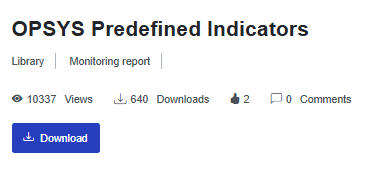Predefined indicators for design and monitoring of EU-funded interventions
Image

|
|---|
Definition and sources of EU predefined indicators
Predefined indicators are good practice indicators. Predefined indicators draw on the Sustainable Development Goals (SDGs), Gender Action Plan (GAP III), the Global Europe Results Framework (GERF), Results and Indicators Guidance, NDICI Regulation, FPI Performance Framework, FPI Results Framework and IPA III Results Framework among other relevant documents. Different kinds exist, namely:
- Predefined indicators used for corporate monitoring and reporting such as: all 17 SDG (Tier I), FPI PF, GERF level 1, GERF level 2, GAP III and IPA III PF indicators
- Sector-specific indicators, grouped by the European Commission priorities:
- Green Deal: Climate Change, Energy, Green Economy, Nutrition, Sustainable Cities, Sustainable Aquatic and Agri-Food Systems, Sustainable Transport, Oceans
- Jobs and Sustainable Growth: Education, Employment and VET, Private sector, Trade
- Human Development, Peace and Governance: Conflict Sensitivity and Peace, Countering Violent Extremism, Health, Human Rights, Justice and Rule of Law, Resilience, Security Sector Reform, Social Protection, Water and Sanitation, Democracy (Media, Civil Registration, Parliaments), Civil Society Organisations (CSOs)
- Digital and Data Technologies: Cybersecurity and Digitalisation
- Migrations and Mobility: Forced Displacement and Remittances
- European Fund for Sustainable Development (EFSD)
A list of predefined indicators by sectors is available at the top of this page.
Use of EU predefined indicators in OPSYS
The selected predefined indicators for the EU external actions are aligned with DGs INTPA, ENEST, MENA and FPI policy priorities. OPSYS suggests them in a drop-down list when users are creating their interventions' logframes. Search and filter functions are available.
OPSYS provides these indicators to enhance the quality of EC's interventions design and monitoring. The use of predefined indicators is not mandatory but highly recommended, as it allows results to be aggregated across interventions and promotes the use of standardised information across European Union-funded interventions in partner countries. We particularly encourage the use of predefined indicators used for corporate monitoring like GERF. Users are able to encode customised indicators, to complete the scope of predefined indicators.
For further information about OPSYS or instruction on how to use of predefined indicators please check EU External Action wiki where you can find the FAQ for Implementing Partners on logframes in OPSYS and e-Learning Videos
Timeline
INTPA is adding further predefined indicators (as well as groups) into OPSYS. You can check this page regularly for the latest list.
Monitoring and reporting results through OPSYS
Since 2021, the European Commission is using OPSYS, an IT platform, to monitor EU-funded interventions outside the European Union and, simultaneously to report on results. We are carrying out the EU external actions results campaign of 2022 directly in OPSYS , namely thanks to the active participation of Operational Managers and Implementing Partners. Our objective is to bring in more efficient, transparent and results-oriented planning, management, and follow-up of EU external actions.
The logical framework approach, includes the narration of a theory of change (an intervention logic) and takes the form of a Logical Framework Matrix (logframe). The latter is the key internal monitoring tool used for results monitoring in OPSYS.
The logframe presents the results that should be generated by an intervention at different time horizons. Result levels (outputs, outcomes and impact) are accompanied by indicators to measure (contribution to) their achievement. Commission services and implementing partners are accessing intervention logframes through OPSYS, as a basis for regular monitoring and reporting.